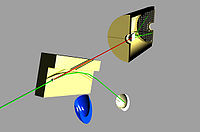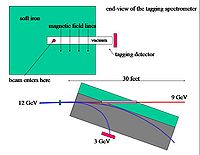Overview of the GlueX experiment
The figure at the right shows the layout of the GlueX experiment.
On the left is the tagging spectrometer and on the right is the GlueX spectrometer. Electrons from the accelerator pass through a diamond crystal just before they enter the tagging spectrometer. Interactions of the high-energy electrons in the diamond produce polarized gamma rays (red rays) of various energies. Most of the gamma rays have very small energy, but every once in a while an electron will have a direct collision with the diamond atoms and produce a gamma ray that carries away a large fraction of the electron's energy, and leave it with a lot less energy than it had when it came out of the accelerator. The gamma rays, both the low-energy and the high-energy ones, travel parallel to the electron beam when they are created. Inside the tagging spectrometer, however, the electrons are bent away from the gamma rays and travel along a curved trajectory (down in the figure) whose curvature depends on their energy. Most of the electrons bend along the gently curve orbit shown in the figure and travel on to the beam dump (white) where they are stopped.
The ones that gave up a significant part of their energy to a gamma ray in the diamond are bent in a tighter orbit in the spectrometer than the rest, and come out of the spectrometer at the location indicated by the tagging detector (dark ellipse). These electrons correspond one-to-one with high-energy gammas (also called high-energy photons) in the photon beam (red line). The photon beam is not deflected by the magnetic field of the spectrometer, so it travels straight out the side of the magnet and is directed downstream toward the GlueX spectrometer. By lining up events in the GlueX spectrometer in time with electrons in the tagging detector, it is possible to "tag" the energy of each energetic photon that produces a high-energy interaction in the experiment. This technique of indirectly measuring the photon beam energy on a photon-by-photon basis by detecting the electron that created it is known as "photon tagging".

